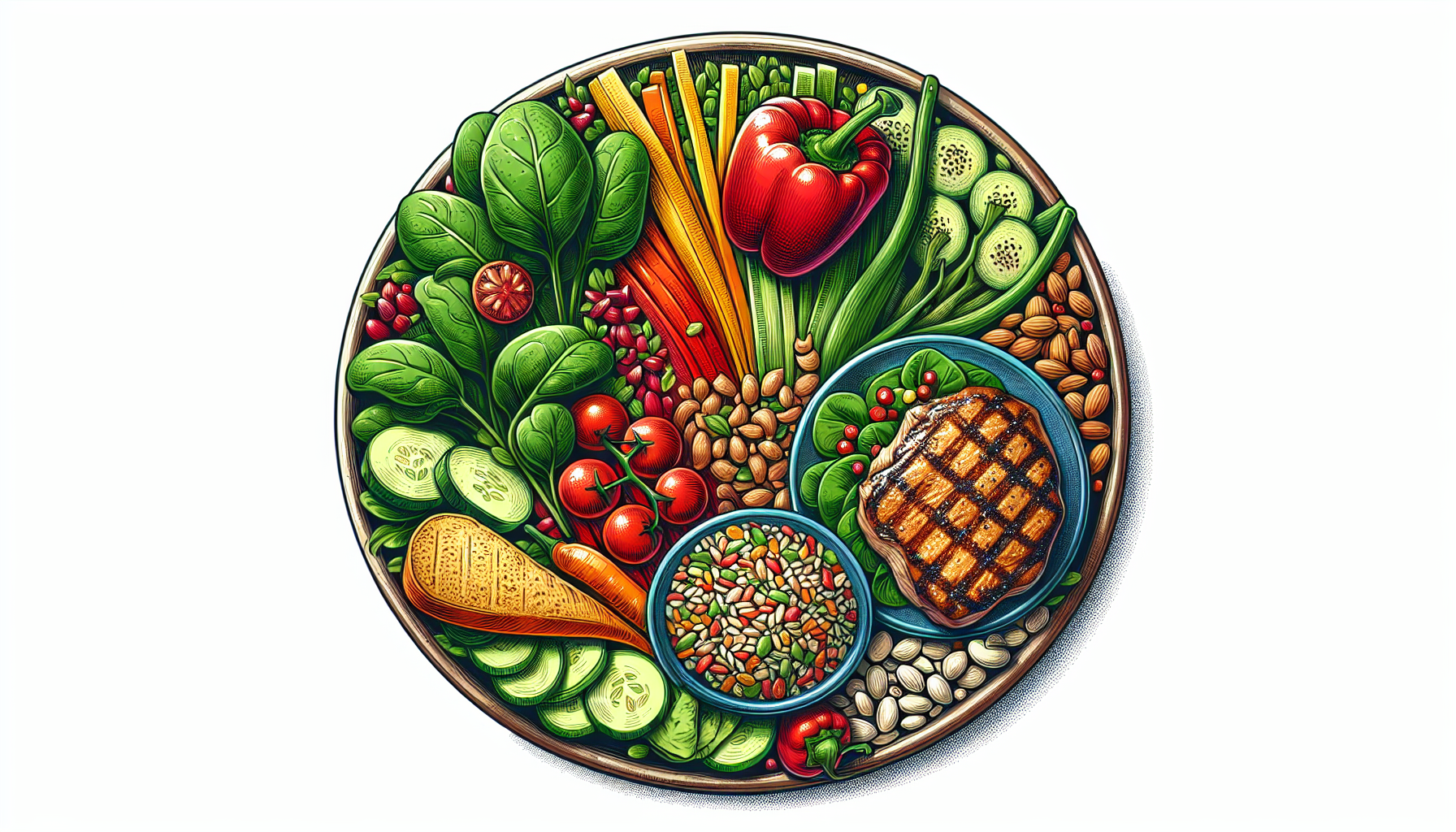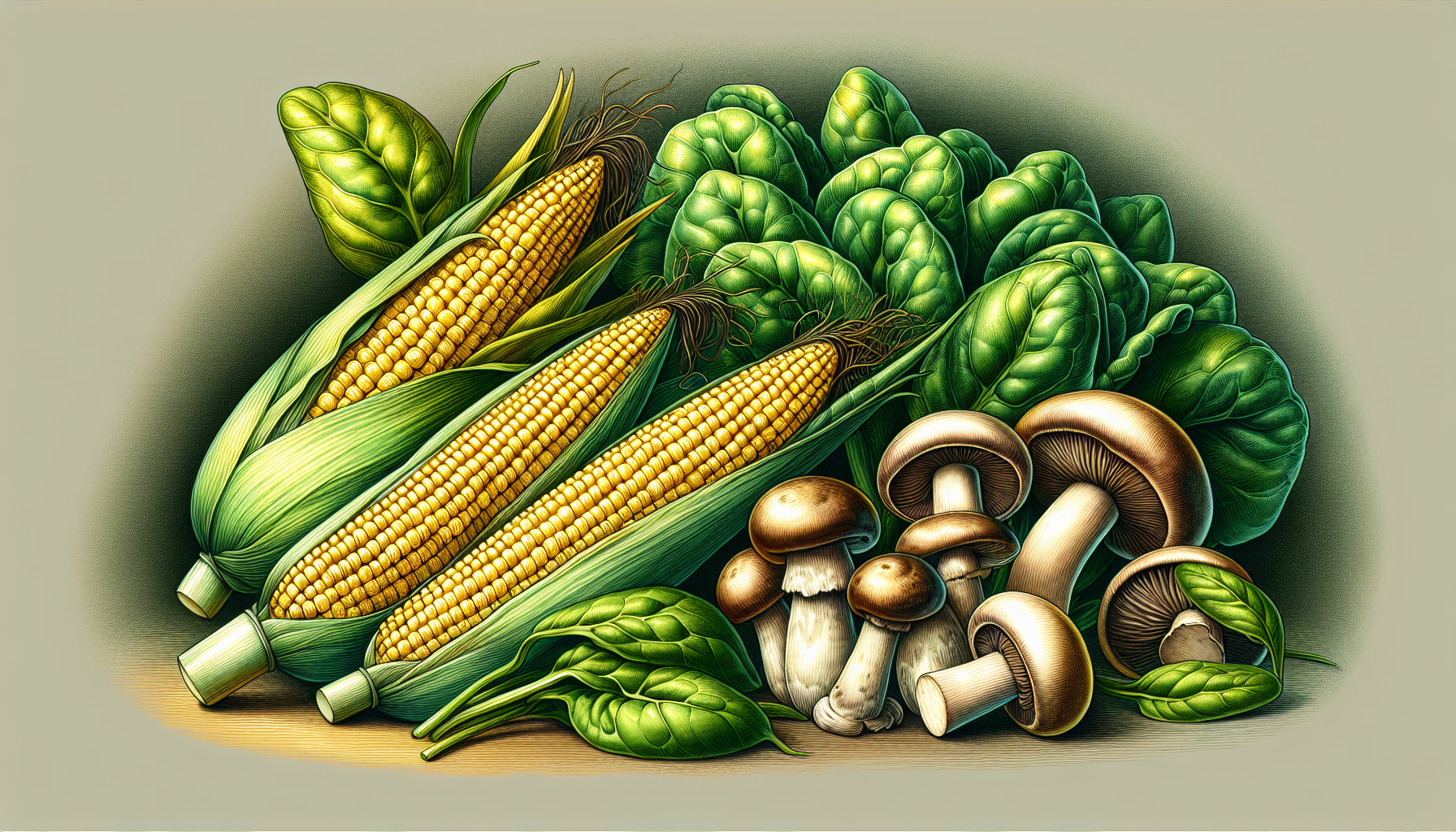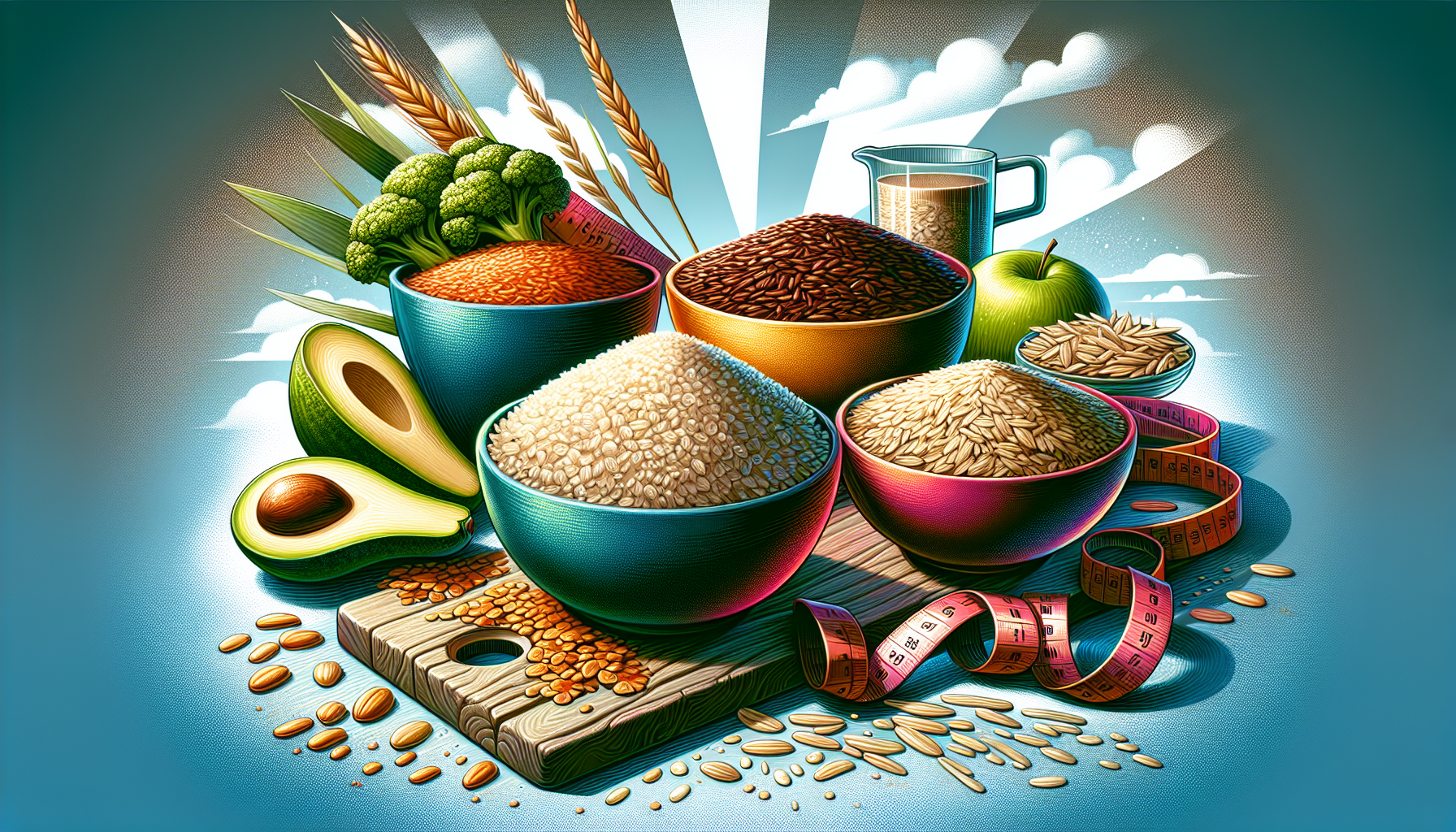Navigating your diet with Ozempic for weight management? Our concise ozempic meal plan strips away the fluff, delivering key dietary actions and foods integral to managing appetite and achieving your wellness objectives. Expect clear-cut guidance on what your plate should look like and how to stay satiated, empowering you with a game plan that meshes with Ozempic’s role in your health regimen.
Key Takeaways
An effective Ozempic meal plan includes non-starchy vegetables, whole grains, nuts, protein-rich foods, and legumes, which helps in managing insulin levels and hunger, mitigating medication side effects, and enabling mindful eating.
The plan emphasizes a balanced diet with a focus on lean proteins, low-carb vegetables, and whole grains over refined alternatives to preserve muscle mass, avoid blood sugar spikes, and provide sustained energy.
It is important to manage portion control, stay hydrated, plan meals with apps like eMeals, complement the diet with regular exercise, adjust the meal plan for special dietary needs, and consult a Registered Dietitian for personalized guidance and optimization.
Crafting Your Ozempic Meal Plan

Imagine a painter with a palette of colors, each one representing a different food group essential to crafting your Ozempic masterpiece. A balanced diet is your canvas, and every brushstroke is a choice that shapes your successful weight loss journey. So, what does this artistry entail? It involves an array of:
Non-starchy vegetables
Whole grains
Nuts
Protein-rich foods
Legumes
All carefully selected to complement the Ozempic diet. Each ingredient plays a significant role in managing insulin levels and curbing hunger, crucial for maintaining a healthy eating routine and mitigating the side effects of Ozempic.
Mindful eating goes hand in hand with this creative process, transforming your Ozempic diet plan from a mere list of foods into an expression of self-care. It’s about nourishing the body and soul, embracing habits that bring joy and satisfaction without compromising on health. As we delve deeper into the components of this plan, remember that each meal is an opportunity to support your body’s needs, offering a foundation for a gratifying and sustainable lifestyle change.
Key Components of an Ozempic-Friendly Diet
As with any masterpiece, the magic lies in the details. A healthy diet for those on Ozempic is rich in high fiber foods and high protein foods, laying the groundwork for a stable metabolic environment. Whole grains such as brown rice and quinoa, along with lentils and legumes, are like the broad strokes that fill the canvas, providing a high fiber diet that ensures you feel full longer while supplying essential nutrients with less energy density. The inclusion of these food groups, particularly in the context of polycystic ovary syndrome, can be a game-changer in managing insulin resistance and promoting weight loss.
Yet, not all fats are villains in this narrative. Healthy fats, especially those from nuts and seeds, join the ensemble to offer a dose of heart-healthy benefits, turning the ozempic diet into a chorus of varied and harmonious notes. The melody is further enriched with non-starchy vegetables like spinach and kale, unsung heroes that offer volume and nutrients without excess calories or carbohydrates, mastering hunger management and weight control.
What’s more, the careful selection of certain foods can alleviate some of the side effects of ozempic. By emphasizing a balanced diet that limits saturated fats and focuses on low glycemic index choices, the diet plan becomes a tailored suit, designed to enhance the medication’s effectiveness and support a healthy lifestyle. It’s about making informed choices that harmonize with your health goals, creating a symphony of benefits that resonate well beyond the dinner table.
Structuring Your Meals
Creating a well-structured meal is akin to composing a symphony, with each element playing its part to create a harmonious whole. The Plate Method acts as the conductor, guiding you to fill your plate with:
Half with the vibrant colors of non-starchy vegetables
A quarter with the rich tones of lean proteins
The remaining quarter with the complex textures of whole grains or starchy vegetables
It’s a visual and practical approach to portion control, ensuring a balanced diet that supports weight management and blood sugar control.
Consider the rhythm of your day and the ebb and flow of your appetite, particularly as Ozempic can suppress hunger. Planning for smaller meals throughout the day can help you harness this effect to optimize weight loss and maintain steady blood sugar levels. The goal is not to deprive but to delight in every bite, while being mindful of the quantity and quality of the food on your plate. By structuring your meals thoughtfully, you transform eating into an act of balance and beauty, one that nourishes both body and soul.
Incorporating Lean Proteins into Your Diet

The cornerstone of any robust ozempic diet is lean proteins. Picture the strength of a towering oak; that’s the role proteins play in preserving muscle mass while you navigate your weight loss journey. Lean proteins are not merely building blocks for muscles but also kindle the fires of satiety, keeping you content longer and steering you away from unnecessary snacking. With options like plain yogurt and cottage cheese, your palate can revel in variety without the burden of excess fat, all while receiving essential nutrients like Vitamin B and enjoying potential health benefits like lower blood pressure.
Navigating the seas of a healthy diet, lean meats such as skinless chicken and turkey, along with the likes of lentils and beans for the plant-inclined, emerge as lighthouses guiding the way to successful weight management. The added advantage of consulting a registered dietitian cannot be overstated; it’s akin to having a seasoned captain at the helm, offering personalized guidance on the right amount and types of lean proteins to include in your meal plan. With this expert insight, your diet can be finely tuned to your body’s needs, setting a course for a healthy lifestyle that is both satisfying and sustainable.
Emphasizing Low-Carb Vegetables

Vegetables are the unsung heroes of a balanced diet, and when it comes to an Ozempic meal plan, low-carb varieties take center stage. They are like the background in a painting, unassuming yet essential, providing a rich tapestry of vitamins and minerals without causing dramatic blood sugar spikes. Envision your plate adorned with the greens of spinach, the purples of eggplant, and the whites of mushrooms — it’s a kaleidoscope of low-carb delights that support your journey.
Yet, as with any masterpiece, moderation is key. While non-starchy vegetables are encouraged, it’s wise to consume starchy vegetables like potatoes and carrots judiciously. Think of them as bold accents in your meal composition, used sparingly to avoid quickly raising blood sugar levels. By emphasizing the inclusion of low-carb veggies and being mindful of their starchy counterparts, you craft a meal plan that is not only visually appealing but also nutritionally sound, supporting your health goals with every vibrant forkful.
Choosing Whole Grains Over Refined Alternatives

In the realm of carbohydrates, whole grains reign supreme, especially for those on an Ozempic diet. Imagine these grains as the slow-burning candles of your meal, casting a gentle light that lasts, providing sustained energy and aiding in blood sugar control. Some examples of whole grains include:
Quinoa
Brown rice
Oats
Whole-wheat pasta
These grains are not just grains; they are beacons of health, guiding you towards a balanced diet with their unrefined wholesomeness.
In stark contrast, refined grains have been stripped of their nutritional value, much like a painting robbed of its depth. White bread and white rice may appear innocent, but they lack the fiber and essential vitamins that their whole grain counterparts proudly offer. By choosing whole grains, you choose a path that leads not only to better health but also to a more fulfilling ozempic diet, one that satisfies without empty promises or empty calories.
The Role of Healthy Fats in Your Meal Plan

Fats have often been misunderstood, but in the context of an Ozempic meal plan, healthy fats are akin to the gold leaf in a gilded masterpiece. They add luster and richness to your diet, supporting heart health and overall well-being. Unsaturated fats, found in sources like olive oil and nuts, are the brushstrokes that help absorb vitamins and minerals, making your meal plan shine with health benefits recommended by the American Heart Association.
But it’s not just about adding shine; it’s also about reducing inflammation. Nuts, with their omega-3 and omega-6 fatty acids, are like the soothing tones that calm a scene, reducing inflammation levels for improved health. Mono and polyunsaturated fats from olives, seeds, and fatty fish should be woven into your meals, ensuring that each bite contributes not just to flavor but also to your metabolic health.
Embrace these sources of healthy fats as treasured elements of your diet, and you’ll find that they enrich your journey towards wellness and help in preventing heart disease in more ways than one, especially when compared to high fat foods.
Smart Snacking on Ozempic
Snacking smartly while on Ozempic is like finding hidden treasures in your daily routine — small, nutrient-dense gems that prevent nutrient deficiencies and keep you energized. Imagine the crunch of fresh vegetables, the creaminess of plain yogurt, or the satisfaction of whole grain crackers topped with cottage cheese. These aren’t just snacks; they’re strategic selections that complement your ozempic diet plan, providing you with the vitamins and minerals your body craves.
Fiber from fruits and vegetables acts like the weaver’s thread, maintaining the integrity of your digestive system, a crucial consideration given Ozempic’s effects. And let’s not forget the role of fermented foods like yogurt and kefir, which may boost the body’s natural GLP-1 hormone, much like Ozempic does, offering a harmonious addition to your medication’s activity. As you reach for that midday snack, choose options that will sustain your energy and maintain your blood sugar levels, like the steadfast nuts that provide lasting satisfaction.
Managing Cravings and Portions
To navigate the ebbs and flows of cravings and portion sizes, one must embrace the art of mindful eating. It’s about savoring each flavor and texture, much like one would linger over the details in a piece of art. Including an array of non-starchy vegetables in your meals ensures you’re not only satisfied but also meeting your daily nutritional needs without excess calories, aiding in your weight management goals.
Remember, Ozempic assists in decreasing appetite, naturally leading to better control over the amount you eat. It also helps quiet the ‘food noise,’ those persistent thoughts about food that can lead to cravings. Be gentle with yourself, especially during dietary slip-ups. It’s part of the journey, much like the unexpected twists in a story that ultimately lead to a satisfying conclusion.
By engaging in mindful eating and monitoring what you consume, you enhance your ability to lose weight by:
Manage portions
Control cravings
Set the stage for a successful weight loss journey that is as much about mental well-being as it is about physical health.
Hydration and Ozempic: What to Drink
Hydration on Ozempic is crucial for stability and function. It supports:
Organ function
Joint cushioning
Blood pressure regulation
Proper digestion
While the specific water intake for individuals on Ozempic isn’t set in stone, following general recommendations and monitoring the color of your urine can be excellent guides to ensure proper hydration levels are maintained.
To stay hydrated, consider the following beverages:
Low-sugar drink mixes
Electrolyte powders
Herbal teas
Water infused with fruits or herbs
These options offer hydration without the excess sugar that can derail blood sugar control. Moderation in alcohol and caffeine intake is also crucial for controlling blood sugar levels, as they can exacerbate side effects and risk dehydration.
By choosing your drinks wisely, you enhance your Ozempic regimen’s effectiveness and support your overall well-being.
Planning Ahead: Ozempic Meal Plans with the eMeals app
Preplanning with the eMeals app is like having a map for your dietary journey, reducing stress and ensuring you consume nutritious meals that align with your Ozempic regimen. Imagine a plan that includes:
a symphony of lean proteins
a rainbow of non-starchy vegetables
a selection of fruits rich in vitamins
healthy fats from nuts and avocados
the satisfying textures of whole grains like brown rice and quinoa
All harmoniously balanced to create delicious and nutritious meals.
The sample meal plan designed for Ozempic users aims to provide approximately 1,800 calories, ensuring you have enough energy for metabolic health while supporting your weight management goals. By using tools like eMeals, you can navigate your dietary choices with confidence, knowing that each meal is a step towards a healthier, happier you.
Exercise as a Complement to Your Ozempic Diet
Exercise is the dance partner to your Ozempic diet, enhancing its weight loss efficacy and supporting your overall health. Incorporating a mix of strength, cardiovascular, and flexibility training into your routine amplifies the benefits of your dietary efforts, much like how different instruments come together to create a symphonic masterpiece.
Regular physical activity is essential, not just for burning calories but for sustaining the weight management progress you’ve achieved with Ozempic. The Semaglutide Diet Plan is a holistic approach, where physical activity and healthy eating play equal roles in crafting a lifestyle conducive to weight loss and diabetes prevention. Embrace this comprehensive strategy, and watch as your body and mind harmonize, each step and each meal becoming part of a grander performance in your health journey.
Adjusting Your Ozempic Meal Plan for Special Diets
Just as a tailor adjusts a garment to fit perfectly, so must an Ozempic meal plan be customized for those with special dietary needs, such as gluten intolerance or conditions like polycystic ovary syndrome (PCOS). For individuals with gluten intolerance, traditional grains are swapped for gluten-free whole grains like rice, quinoa, buckwheat, and millet, ensuring the diet remains free from gluten while still rich in nutrients. These whole grains become the new staples, offering the same satisfying texture and taste without the gluten.
Those with PCOS, particularly if significantly overweight, may find Ozempic a suitable prescription medication, but dietary adjustments are often necessary to accommodate the condition. It’s about fine-tuning your diet to meet your body’s unique needs, potentially reducing symptoms and enhancing the effectiveness of Ozempic.
A balanced diet, rich in fiber, lean proteins, and low in refined sugars, can be a powerful ally in managing PCOS symptoms, just as the right ingredients can transform a recipe into a culinary delight.
Foods to Limit or Avoid on Ozempic
Every diet has its cautionary tales, and with an Ozempic diet plan, certain foods take on the role of the antagonists in our story. The usual suspects are:
Heavily processed foods
High-fat cuts of meat
Sugary snacks
Alcohol
These foods can potentially sabotage weight management efforts and amplify undesirable side effects. Think of them as the foods that lurk in the shadows, tempting with their convenience and taste, but ultimately not contributing positively to your health narrative.
To steer clear of these pitfalls, focus on:
Whole, nutrient-dense foods
Limiting the consumption of refined grains
Limiting the consumption of sugary foods with added sugars
Limiting the consumption of fried foods
Limiting the consumption of sugary drinks
These are the villains in the world of an ozempic diet, empty of nutrients and full of empty promises. By avoiding them, you set yourself up for success, ensuring your meals are as effective as the medication itself in managing your weight and health.
The Importance of Consulting a Registered Dietitian
Embarking on an Ozempic journey without the guidance of a Registered Dietitian is like setting sail without a compass. A dietitian serves as your navigator, offering personalized advice and adapting your meal plan to suit your individual health needs and preferences. With their expertise, you can ensure your diet is not only effective but also tailored to your unique situation, optimizing your weight loss results and overall health.
Moreover, a Registered Dietitian can be invaluable in managing the side effects of Ozempic, providing you with tailored recommendations based on the latest nutritional science. They offer support and strategies that can make your weight loss journey smoother, helping you to make informed choices that propel you towards your goals. Trust in their knowledge and experience, and you’ll find that your dietary choices become more intuitive, more effective, and more rewarding.
Summary
As we conclude our journey through the intricacies of an Ozempic meal plan, let’s recap the key ingredients that make it effective. A balanced diet rich in lean proteins, low-carb vegetables, and whole grains forms the foundation. Healthy fats add richness and nutrients, while smart snacking keeps your energy levels steady. Mindful eating, portion control, and staying hydrated are the brushstrokes that add depth and detail to the picture of your health.
Remember, this is not just about losing weight; it’s about crafting a lifestyle that endures, a canvas that you paint with each meal and each choice. Exercise complements your diet, adding vitality and strength, while adjustments for special diets ensure your meal plan fits you like a glove. Avoiding certain foods keeps your palette clean, and consulting a Registered Dietitian adds the expertise needed to bring your health masterpiece to life. Embrace this guide as a starting point, and let it inspire you to create a meal plan that sings in harmony with your body’s needs.
Frequently Asked Questions
Can I still enjoy my favorite foods while following an Ozempic diet plan?
Yes, you can still enjoy your favorite foods while following an Ozempic diet plan, but it’s important to practice moderation and pay attention to portion sizes for blood sugar control.
How much water should I drink while on Ozempic?
To stay adequately hydrated on Ozempic, aim to drink around 91 ounces for women and 125 ounces for men from all sources, and monitor your hydration by checking the color of your urine.
Is it necessary to exercise while on Ozempic?
Yes, it is necessary to exercise while on Ozempic to enhance weight loss efficacy and support overall health. Include a mix of strength, cardio, and flexibility training in your routine.
What should I do if I experience cravings while on Ozempic?
To manage cravings while on Ozempic, practice mindful eating, choose snacks high in fiber and protein, and remember that Ozempic may naturally decrease your appetite, aiding in managing cravings.
How do I adjust my meal plan if I have a special diet, like gluten intolerance?
To adjust your meal plan for gluten intolerance, focus on naturally gluten-free whole grains and avoid processed gluten-free products. It’s also advisable to consult a Registered Dietitian for personalized adjustments.
